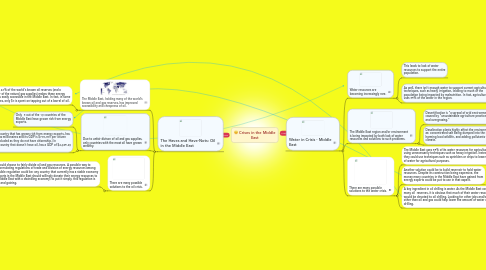
1. The Haves and Have-Nots: Oil in the Middle East
1.1. The Middle East, holding many of the world's known oil and gas reserves, has improved accessibility and cheapness of oil.
1.1.1. Having 46% of the world's known oil reserves (and a quarter of the natural gas supplies) makes these energy exports easily accessible in the Middle East. In fact, in some countries, only $3 is spent on tapping out of a barrel of oil.
1.1.1.1. With many oil and gas reserves primarily situated near the coastal regions of the Middle East, it is possible that the nearby water sources can be polluted through drilling. There may have been instances of not being able to filter out all of the pollutants and the water being unfit for drinking, wasting many valuable water resources.
1.2. Due to unfair divison of oil and gas supplies, only countries with the most oil have grown wealthy.
1.2.1. Only 8 out of the 19 countries of the Middle East have grown rich from energy exports.
1.2.2. For example, Qatar, a country that has grown rich from energy exports, has 14% of its households as millionaires and its GDP is $700,000 per citizen (foreign workers are excluded as they do not have citizenship.) In comparison, Jordan, a country that doesn't have oil, has a GDP of $4,945.49 per person.
1.2.2.1. The importance of oil in the Middle East is indeed apparent when oil prices change drastically.
1.2.2.2. Furthermore, based on how foreign workers are excluded from the wealthiness of Qatar leads to the conclusion of either racial bias or economic exclusion.
1.3. There are many possible solutions to the oil crisis.
1.3.1. The Middle East could choose to fairly divide oil and gas resources. A possible way to ensure this is by formulating regulations of trade and division of energy resources among the region. A possible regulation could be: any country that currently has a stable economy due to energy exports in the Middle East should willingly donate their energy resources to a country in the Middle East with a dwindling economy; to put it simply, this regulation is focused on losing and gaining.
2. Water in Crisis - Middle East
2.1. Water resources are becoming increasingly rare.
2.1.1. This leads to lack of water resources to support the entire population.
2.1.2. As well, there isn't enough water to support current agricultural techniques, such as heavy irrigation, leading to much of the population being impacted by malnutrition. In fact, agriculture uses 85% of the water in the region.
2.1.2.1. This means that more people have a chance of getting dehydrated, or even dying. Also, people could get sick and not have the money to pay for medicine.
2.1.2.2. Malaysia, a country that has a similar climate to the Middle East, uses 34% of their water supplies in comparison to the 85% the Middle East uses for agriculture.
2.2. The Middle East region and/or environment is being impacted by both lack of water resources and solutions to such problems.
2.2.1. Desertification is "a spread of arid environment" caused by "unsustainable agriculture practices and overgrazing."
2.2.2. Desalination plants highly affect the environment such as: concentrated salt being dumped into the ocean, harming local wildlife, and adding pollutants to the climate.
2.2.2.1. Additional pollutants in the climate, caused by desalination plants, could further increase the temperature and drastically impact the Middle East. Much of the Middle East has an arid (dry and semi-dry) climate which can cause continuous droughts. This would lead to strain of undersized water resources.
2.3. There are many possible solutions to the water crisis.
2.3.1. The Middle East uses 85% of its water resources for agriculture, using unnecessarily techniques such as heavy irrigation. Instead, they could use techniques such as sprinklers or drips to lower use of water for agricultural purposes.
2.3.2. Another solution could be to build reservoir to hold water resources. Despite its construction being expensive, the money many countries in the Middle East have gained from energy exports could be put to use in that aspect.
2.3.3. A key ingredient in oil drilling is water. As the Middle East contains many oil reserves, it is obvious that much of their water resources would be devoted to oil drilling. Looking for other jobs and/or exports other than oil and gas could help lower the amount of water used for oil drilling.
